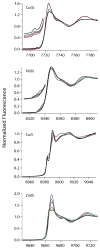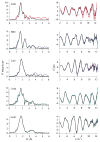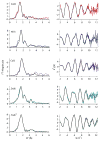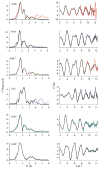Effects of select histidine to cysteine mutations on transcriptional regulation by Escherichia coli RcnR
- PMID: 23215580
- PMCID: PMC3610428
- DOI: 10.1021/bi300886q
Effects of select histidine to cysteine mutations on transcriptional regulation by Escherichia coli RcnR
Abstract
The RcnR metalloregulator represses the transcription of the Co(II) and Ni(II) exporter, RcnAB. Previous studies have shown that Co(II) and Ni(II) bind to RcnR in six-coordinate sites, resulting in derepression. Here, the roles of His60, His64, and His67 in specific metal recognition are examined. His60 and His64 correspond to ligands that are important for Cu(I) binding in the homologous Cu(I)-responsive metalloregulator, CsoR. These residues are known to be functionally important in RcnR transcriptional regulation. X-ray absorption spectroscopy (XAS) was used to examine the structure of bound cognate and noncognate metal ions, and lacZ reporter assays were used to assess the transcription of rcnA in response to metal binding in the three His → Cys mutations, H60C, H64C, and H67C. These studies confirm that both Ni(II) and Co(II) use His64 as a ligand. H64C-RcnR is also the only known mutant that retains a Co(II) response while eliminating the response to Ni(II) binding. XAS data indicate that His60 and His67 are potential Co(II) ligands. The effects of the mutations of His60, His64, and His67 on the structures of the noncognate metal ions [Zn(II) and Cu(I)] reveal that these residues have distinctive roles in binding noncognate metals. None of the His → Cys mutants in RcnR confer any response to Cu(I) binding, including H64C-RcnR, where the ligands involved in Cu(I) binding in CsoR are present. These data indicate that while the secondary, tertiary, and quaternary structures of CsoR and RcnR are quite similar, small changes in primary sequence reveal that the specific mechanisms involved in metal recognition are quite different.
Figures






Similar articles
-
Role of the N-terminus in determining metal-specific responses in the E. coli Ni- and Co-responsive metalloregulator, RcnR.J Am Chem Soc. 2012 Apr 25;134(16):7081-93. doi: 10.1021/ja300834b. Epub 2012 Apr 11. J Am Chem Soc. 2012. PMID: 22471551 Free PMC article.
-
Glutamate Ligation in the Ni(II)- and Co(II)-Responsive Escherichia coli Transcriptional Regulator, RcnR.Inorg Chem. 2017 Jun 5;56(11):6459-6476. doi: 10.1021/acs.inorgchem.7b00527. Epub 2017 May 18. Inorg Chem. 2017. PMID: 28517938 Free PMC article.
-
Ni(II) Sensing by RcnR Does Not Require an FrmR-Like Intersubunit Linkage.Inorg Chem. 2019 Oct 21;58(20):13639-13653. doi: 10.1021/acs.inorgchem.9b01096. Epub 2019 Jun 17. Inorg Chem. 2019. PMID: 31247878
-
The SmtB/ArsR family of metalloregulatory transcriptional repressors: Structural insights into prokaryotic metal resistance.FEMS Microbiol Rev. 2003 Jun;27(2-3):131-43. doi: 10.1016/S0168-6445(03)00054-8. FEMS Microbiol Rev. 2003. PMID: 12829264 Review.
-
Coordinating intracellular nickel-metal-site structure-function relationships and the NikR and RcnR repressors.Nat Prod Rep. 2010 May;27(5):658-67. doi: 10.1039/b906683g. Epub 2010 Mar 5. Nat Prod Rep. 2010. PMID: 20442957 Review.
Cited by
-
Co(II) and Ni(II) binding of the Escherichia coli transcriptional repressor RcnR orders its N terminus, alters helix dynamics, and reduces DNA affinity.J Biol Chem. 2018 Jan 5;293(1):324-332. doi: 10.1074/jbc.RA117.000398. Epub 2017 Nov 17. J Biol Chem. 2018. PMID: 29150441 Free PMC article.
-
Metal specificity of cyanobacterial nickel-responsive repressor InrS: cells maintain zinc and copper below the detection threshold for InrS.Mol Microbiol. 2014 May;92(4):797-812. doi: 10.1111/mmi.12594. Epub 2014 Apr 14. Mol Microbiol. 2014. PMID: 24666373 Free PMC article.
-
Insights into Protein Allostery in the CsoR/RcnR Family of Transcriptional Repressors.Chem Lett. 2014 Jan 5;43(1):20-25. doi: 10.1246/cl.130965. Chem Lett. 2014. PMID: 24695963 Free PMC article.
-
Unique effect of Cu(II) in the metal-induced amyloid formation of β-2-microglobulin.Biochemistry. 2014 Mar 4;53(8):1263-74. doi: 10.1021/bi4016583. Epub 2014 Feb 21. Biochemistry. 2014. PMID: 24450572 Free PMC article.
-
Generating a Metal-responsive Transcriptional Regulator to Test What Confers Metal Sensing in Cells.J Biol Chem. 2015 Aug 7;290(32):19806-22. doi: 10.1074/jbc.M115.663427. Epub 2015 Jun 24. J Biol Chem. 2015. PMID: 26109070 Free PMC article.
References
-
- Rosenzweig AC. Metallochaperones: bind and deliver. Chem Biol. 2002;9:673–677. - PubMed
-
- Pennella MA, Giedroc DP. Structural determinants of metal selectivity in prokaryotic metal-responsive transcriptional regulators. BioMetals. 2005;18:413–428. - PubMed
-
- Böck A, King PW, Blokesch M, Posewitz MC. Maturation of hydrogenases. Adv Microb Physiol. 2006;51:1–71. - PubMed
-
- Forzi L, Sawers RG. Maturation of [NiFe]-hydrogenases in Escherichia coli. BioMetals. 2007;20:565–578. - PubMed
-
- De Pina K, Navarro C, McWalter L, Boxer DH, Price NC, Kelly SM, Mandrand-Berthelot MA, Wu LF. Purification and characterization of the periplasmic nickel-binding protein NikA of Escherichia coli K12. Eur J Biochem. 1995;227:857–865. - PubMed
Publication types
MeSH terms
Substances
Grants and funding
LinkOut - more resources
Full Text Sources

